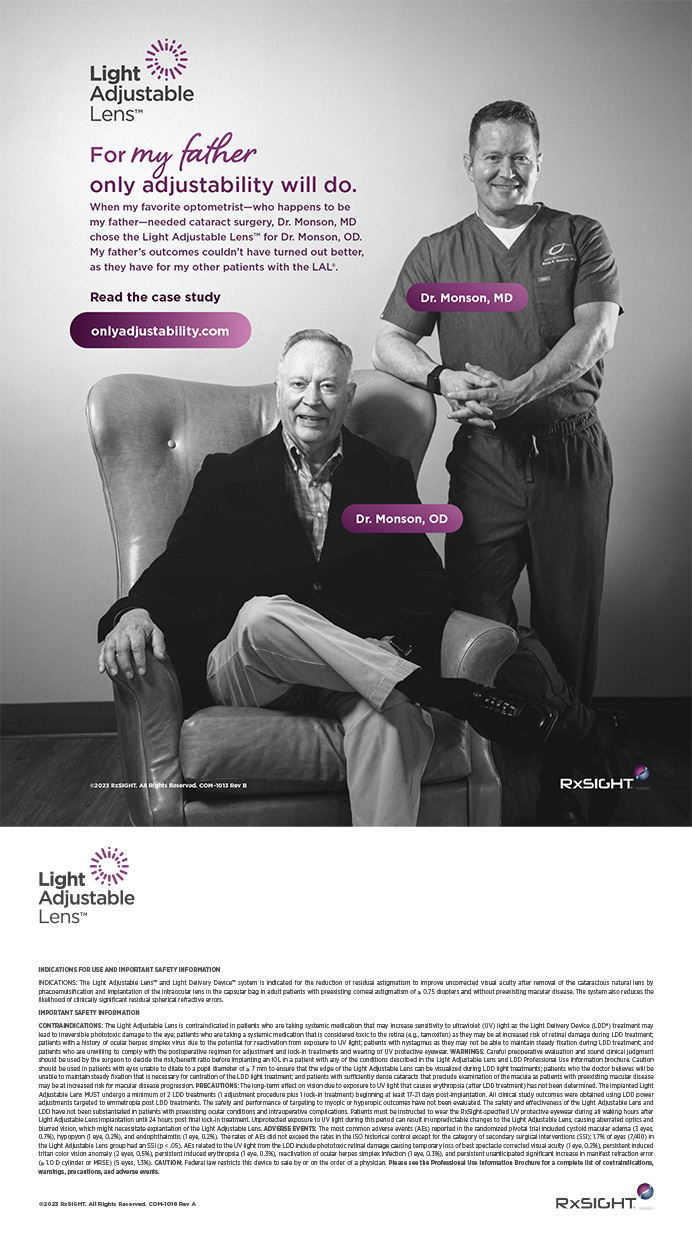Elevated IOP is common following cataract surgery, and surgeons cannot always predict which patients will experience a spike in IOP. Sometimes, the problem is transient, and many patients can tolerate postoperatively elevated IOP. Unfortunately, it can threaten the vision of others. Patients with a history of glaucomatous cupping, compromised retinal vasculature, or corneal endothelial disease are vulnerable to complications, especially when the IOP is over 30 mm Hg. In these individuals, preventive measures during surgery and immediately after the procedure are essential.
INTRAOPERATIVE PREVENTION
Of the various etiologies for elevated pressure after cataract surgery, ophthalmologists often finger topical steroids as a culprit. Actually, these agents are rarely the cause of IOP spikes during the immediate postoperative period. Typically, 3 to 6 weeks of continuous dosing is needed to elicit an IOP response.
The most common reason for elevated IOP after uncomplicated cataract surgery is that retained viscoelastic in the trabecular meshwork is blocking the egress of aqueous. Although the problem typically lasts only 24 to 36 hours, the rise in IOP can be dramatic and thus of great concern.
Intracameral cholinergic agents appear to be of limited use in blunting the increase in IOP in the setting of retained viscoelastic. The best way to avoid the problem is meticulous surgical technique, including careful I/A of the viscoelastic material.
POSTOPERATIVE MANAGEMENT
Burping the Wound
There are various options for restoring normal IOP after cataract surgery. The most direct approach involves releasing viscoelastic and aqueous from the eye (often referred to as burping the wound) through the paracentesis site. The procedure is performed in the examination room with the patient sitting at the slit lamp.
After checking the IOP (and with the eye topically anesthetized), I penetrate the paracentesis site carefully with a 30-gauge needle and allow a few drops of aqueous and viscoelastic to escape the wound. Gentle pressure with the needle on the posterior lip of the entry site facilitates the release of aqueous. A speculum is usually unnecessary. Immediately afterward, I apply a topical antibiotic.
One may burp the wound repeatedly, as needed, in order to achieve an IOP at the desired level. It is important to remember that releasing aqueous through the paracentesis site reduces the IOP only briefly. Applying topical hypotensive drops helps maintain the reduction in pressure until the viscoelastic has disappeared completely.
Pharmacological Intervention
Normalizing the IOP after cataract surgery demands a fully functional outflow system. Patients with preexisting ocular hypertension, glaucoma, or a compromised outflow facility are at risk for a postoperative rise in IOP. The problem may occur even after an uncomplicated cataract procedure due to surgical trauma and inflammation of the anterior segment. In such cases, it is useful to pretreat the eye at the conclusion of surgery with aqueous suppressants to prevent an increase in pressure.
I recommend using aqueous suppressants such as the alpha agonists (apraclonidine or brominidine), beta-blockers (timolol), or carbonic anyhydrase inhibitors (acetazolamide, dorzolamide, or brinzolamide). At times, a combination of these agents may be necessary. The outflow drugs—especially the prostaglandin analogs—are less effective in the immediate postoperative setting, because they require a more prolonged onset of action and may induce anterior segment inflammation. In patients with glaucomatous cupping and visual field loss or anyone who can ill afford a marked postoperative rise in IOP, it is advisable to combine cataract and glaucoma surgery.
COMPLICATED CASES
One should anticipate IOP-related problems in patients whose cataract surgery is difficult, particularly cases of capsular tears with or without nuclear fragments dropped into the vitreous. The combination of prolonged surgery, inflammation, retained lenticular fragments, and the IOL's modified placement is a red flag for spiking pressure. Careful cleanup of the anterior segment with removal of the residual nuclear material is important for avoiding elevated IOP as well as other complications.
Hypotensive medications following complicated cataract surgery are often ineffective at controlling pressure. I recommend performing surgery (including pars plana vitrectomy and lensectomy for the dropped nucleus and vitreous debris) early in the postoperative period to control the IOP and prevent other visual complications. One should not assume, however, that vitreous surgery successfully controls the pressure in all cases; complicated cataract surgery jeopardizes outflow facility, and patients can develop prolonged increases in pressure. Filtering surgery may be required for definitive IOP control.
CONCLUSION
Meticulous surgical technique, prophylactic medications in high-risk patients, and burping the wound can help to avoid pressure-related complications. Fortunately, many, if not most, postoperative problems related to IOP are transient.
Richard A. Lewis, MD, is a consultant in glaucoma in Sacramento, California. Dr. Lewis may be reached at (916) 649-1515; rlewiseyemd@yahoo.com.


